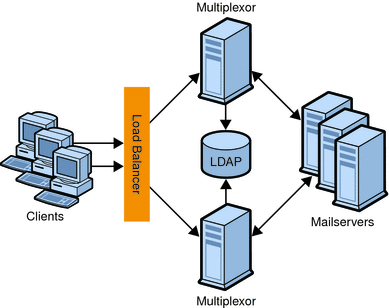Using MMPs
The MMP enables you to mask the layout of your Messaging Server hosts from your end users. Consequently, you assign users to a generic MMP or a load balancer without having them point to the specific server where their mail boxes reside. Message access clients point to the MMP for retrieving incoming messages.
When such a client connects and authenticates, the MMP looks up the user information in the directory to determine where the user’s messages are held. The MMP then connects the client to that specific server. The following figure shows how the MMP acts as a proxy for IMAP4 and POP3 connections to Messaging servers. Figure 12–6 shows how multiplexors function in a Messaging Server environment.
Figure 12–6 MMP Overview

Use a load balancer in front of the multiple MMPs. It is unlikely that you would have a single MMP.
Using the MMP SMTP Proxy
The MMP contains an SMTP proxy that is designed to accept messages but not transfer messages. Because of this design, never use the MMP SMTP Proxy as the target of a DNS MX record or to otherwise receive mail incoming from arbitrary sources on the Internet. Messaging Server does not support the use of the MMP SMTP Proxy in a message transfer capacity.
Messaging Server does support the use of the MMP SMTP proxy for message submission from end-user clients. However, the multiplexing functionality of the MMP, which is necessary to distribute POP and IMAP connections to the correct back-end store, is not necessary for SMTP submission. You can balance SMTP submission by MX records for mail clients that follow the standard, or by a simple load balancer for mail clients that do not follow the standard.
Only use the MMP SMTP Proxy in the following situations:
-
If the MTA is becoming impeded with SSL/TLS processing, the MMP SMTP proxy can offload that processing for message submission while still supporting standard SMTP STARTTLS.
-
If the MMP has SSL hardware acceleration for POP/IMAP, it might make sense to also leverage that for SMTP submission.
-
If you need to use the "POP before SMTP" mechanism, then the MMP SMTP Proxy is required.
-
The MMP SMTP proxy has a desired feature not present in the back-end MTA.
-
If your deployment requires a proxy, then use the MMP SMTP proxy, which is specifically designed to preserve the security features and SMTP extensions present in the MTA and uses a custom SMTP extension (XPEHLO) to do so safely.
Note –
The MMP SMTP Proxy only works with Messaging Server's SMTP server as a back-end.
- © 2010, Oracle Corporation and/or its affiliates
